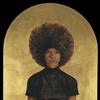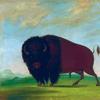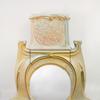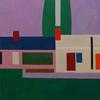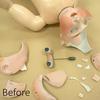MINIATURE MASTERPIECES: RUSSIAN LACQUER BOXES OPENS AT MUSEUM OF RUSSIAN ICONS
- CLINTON, Massachusetts
- /
- October 16, 2020

Miniature Masterpieces: Russian Lacquer Boxes, an exhibition featuring more than 100 intricately painted lacquer boxes widely renowned for their exquisite detail and bright colors will be on view at the Museum of Russian Icons, October 30, 2020 – March 31, 2021. The development of Russian lacquerware from the four small rural villages of Fedoskino, Palekh, Kholui, and Mstera, is a fascinating story of artists adapting local traditions to produce new enterprises. The papier-mâché treasures, decorated with miniature paintings of folk scenes and fairytales, are lacquered and polished to a high sheen. This exhibition is made possible through the generous gift of lacquer boxes from the private collection of Dennis H. and Marian S. Pruslin.
The art of Russian lacquer, among the most beautiful and distinctive of Russia's art achievement in the 20th century, is deeply rooted in the art of icon painting. After the Bolshevik Revolution of 1917, the icon painters who previously had been employed creating icons for churches and private homes, needed a way to make a living. They shifted their creativity to the craft of making papier-mâché decorative boxes and panels that featured intricately hand-drawn miniature paintings based on a variety of secular themes, including fairy tales, poems, country life, troikas (a three-horse led carriage), landscapes, battle scenes, and old art masterpieces. Taking their name from the many layers of lacquer (most often, black and red) that are applied both inside and out, the boxes are known for their stunning shine.
This history of Russian lacquer boxes is a fascinating story of the artist as entrepreneur, drawing on and adapting local traditions. This art form first appeared in Russia in the eighteenth century, when Peter the Great commissioned lacquered panels, painted by Russian iconographers, to decorate a room at his Monplaisir Palace. As with other decorative arts introduced during Peter's reign, the manufacture of lacquerware was gradually taken over by private companies and later, in the Soviet period, by cooperative artels.
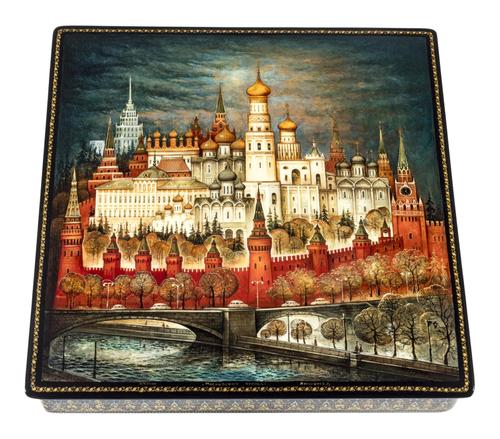
Historically, workshops in the villages of Fedoskino, Palekh, Kholui, and Mstera have been the primary producers of Russian lacquer boxes. Each village is known for its distinctly recognizable style, although thematic considerations greatly vary. Some depict scenes from the lives of both country and city dwellers, while others are based on fairy tales, landscapes, cityscapes, and famous paintings.
In 1795, a merchant named Pavel Korbachov purchased a small village near Fedoskino called Danilkovo, where he established a factory producing lacquered snuff boxes. He hired German artists to train his workers, most of whom were his serfs. They formed snuff boxes out of papier-mâché and decorated them with miniature paintings using oil-based paints, often employing a realistic style.
For centuries, workshops in Palekh, Kholui, and Mstera produced icons, and by the mid-eighteenth century, the economy of these three villages had become entirely reliant on their production. After the Revolution, artists could no longer work as iconographers and sought work elsewhere. In 1924, Ivan Golikov, an iconographer from Palekh, helped found the Artel of Old Painting. He and other artists produced tempera-painted lacquer boxes with a distinctive style based on traditional icons; similar workshops soon opened in Mstera and Kholui.
For decades the factories and workshops were strictly regulated by the collectives under the Soviet Union. When that system collapsed, an influx of inexpensive imitations, partnered with a struggling economy, led to a steep drop in the boxes' value. Many young artists have become iconographers due to the decline of demand for lacquered art and religious renaissance in Russia. Despite this, workshops in the four villages continue to produce lacquer art today, preserving the craft for generations to come.
ABOUT THE VILLAGES
Fedoskino
Fedoskino, near Moscow, is the smallest of the four villages. It is the oldest lacquer box manufacturer in Russia and the first in the area to work with papier-mâché. Lacquer painting began here in the eighteenth century when Ivan Korobov opened a factory, later known as the Lukutin Factory, which specialized in papier-mâché objects. Artists from Feodoskino employed a more realistic painting style, used oil paints instead of egg-based temperas, and often used gold, silver, or mother-of-pearl for their beautifully detailed boxes.
Palekh
Palekh, located near Nizhny Novgorod and Moscow, is historically known for icon painting and began producing lacquer boxes after the Revolution. Master iconographers from Palekh painted papier-mâché boxes, applying the principles learned from painting icons. It did not take long for these miniature masterpieces to become as renowned as the Palekh icons. The artists used bright tempera paint over a lacquered black background to represent themes from daily life, fairy tales, literary works, and folk songs. Today, Palekh artists continue to produce elegantly painted lacquer boxes and exceptionally intricate icons characterized by elaborate gold and/or silver leaf ornamentation that have been called "small miracles."
Mstera
Mstera, or Mstyora, is close to Nizhny Novgorod and Moscow. The village developed around the Theophany Monastery, which may have contributed to the establishment of icon workshops. After the Revolution, Mstera artists began producing various decorative arts, including lacquer boxes. Mstera boxes are known for their multi-colored base coats, a tendency toward realism, and minimal use of gold leaf. Artists seldom choose black for their backgrounds and instead use light blue, pink, gold, or ivory colors.
Kholui
Kholui, or Kholuy, is a rural village near Nizhny Novgorod and Moscow. Its economy is primarily based on artisan crafts, such as textiles, woodworking, and, most notably, lacquer boxes. According to local accounts, icon painting in this region goes back to the thirteenth century. Following the Revolution, this practice shifted to lacquer boxes and other artisan crafts. The Kholui style is the youngest of the four villages and is defined by its warm color palette of deep yellows, browns, and reds.
A special thank you to Erik Livingston for his comprehensive work translating and researching the collection.
ABOUT THE MUSEUM
The Museum of Russian Icons, located at 203 Union Street in Clinton, MA, inspires the appreciation and study of Russian culture by collecting and exhibiting one of the world's largest collections of Russian icons — sacred paintings used for worship in the Orthodox tradition. With more than 1,000 icons and related artifacts spanning six centuries, the Museum offers a unique and personalized experience rich with art, history, and culture.
The Museum serves as a leading center for research and scholarship through the Center for Icon Studies and other institutional collaborations. It is the only museum in the U.S. dedicated to Russian icons, and it is the largest collection of icons outside of Russia.
In order to safely welcome visitors to view the newly reinstalled permanent collection and special exhibitions, the Museum will be implementing new hours, timed ticketing, and a variety of protocols. A maximum of 20 guests will be allowed in the Museum during each time slot. Reservations are required and can be made by calling Visitor Services at 978.598.5000. As well as limiting hours and number of guests, the Tea Room and Auditorium will be closed since there is not enough room for safe social distancing.
MUSEUM HOURS
Friday, Saturday, and Sunday, 11am-5pm. Closed Monday–Thursday
Three daily time slots: 11am-1pm; 1-3pm; 3-5pm.
Admission: Adults $10, seniors (59+) $7, Students $5, Children (3-7) $5, Children under 3 Free.
Follow the Museum of Russian Icons on Facebook, Twitter, and Instagram and Youtube, for the latest updates on the Museum, spotlight tours, children's storytime, and read what the docents are saying about individual items from the collection.
Visit the website, www.museumofrussianicons.org, home of the Online Collection (including research papers on individual icons), a virtual tour of the Museum, the Journal of Icon Studies, and the British Museum's Catalogue of Byzantine and Greek Icons.
Contact:
Nina J BergerMuseum of Russian Icons
6175431595
ninajberger@gmail.com
203 Union Street
Clinton, Massachusetts
info@museumofrussianicons.org
978.598.5000
http://www.museumofrussianicons.org/
About Museum of Russian Icons
The Museum of Russian Icons inspires the appreciation and study of Russian culture by collecting and exhibiting icons and related objects; igniting the interest of national and international audiences; and offering interactive educational programs. The Museum serves as a leading center for research and scholarship through the Center for Icon Studies and other institutional collaborations. It is the only museum in the US dedicated to Russian icons, and it is the largest collection of icons outside of Russia. Museum hours: Tue. - Fri., 11AM to 4PM, first Thurs of the month to 8PM, Saturday and Sunday 11AM to 5PM, closed Mondays. Admission: Adults $10, seniors (59+) $7, Students $5, Children (3-7) $5, Children under 3 Free. For more information please visit museumofrussianicons.org.



